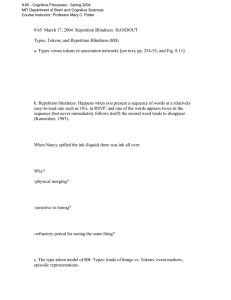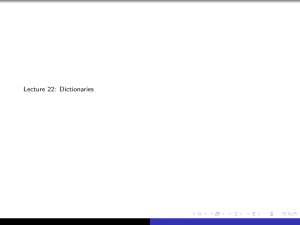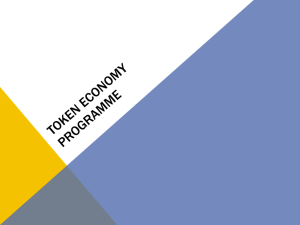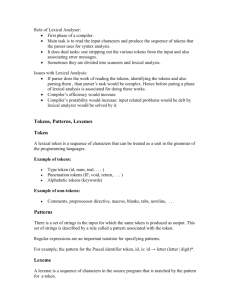An Intelligent Load Balancing Algorithm Towards Efficient Cloud Computing
advertisement
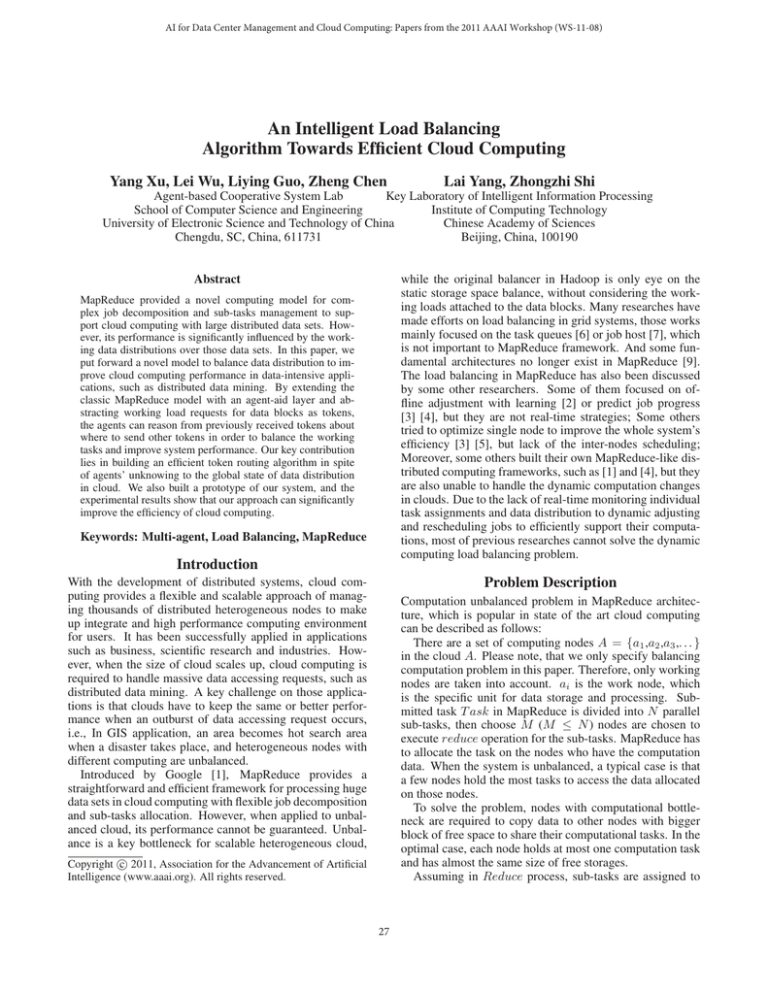
AI for Data Center Management and Cloud Computing: Papers from the 2011 AAAI Workshop (WS-11-08)
An Intelligent Load Balancing
Algorithm Towards Efficient Cloud Computing
Yang Xu, Lei Wu, Liying Guo, Zheng Chen
Lai Yang, Zhongzhi Shi
Agent-based Cooperative System Lab
Key Laboratory of Intelligent Information Processing
School of Computer Science and Engineering
Institute of Computing Technology
University of Electronic Science and Technology of China
Chinese Academy of Sciences
Chengdu, SC, China, 611731
Beijing, China, 100190
while the original balancer in Hadoop is only eye on the
static storage space balance, without considering the working loads attached to the data blocks. Many researches have
made efforts on load balancing in grid systems, those works
mainly focused on the task queues [6] or job host [7], which
is not important to MapReduce framework. And some fundamental architectures no longer exist in MapReduce [9].
The load balancing in MapReduce has also been discussed
by some other researchers. Some of them focused on offline adjustment with learning [2] or predict job progress
[3] [4], but they are not real-time strategies; Some others
tried to optimize single node to improve the whole system’s
efficiency [3] [5], but lack of the inter-nodes scheduling;
Moreover, some others built their own MapReduce-like distributed computing frameworks, such as [1] and [4], but they
are also unable to handle the dynamic computation changes
in clouds. Due to the lack of real-time monitoring individual
task assignments and data distribution to dynamic adjusting
and rescheduling jobs to efficiently support their computations, most of previous researches cannot solve the dynamic
computing load balancing problem.
Abstract
MapReduce provided a novel computing model for complex job decomposition and sub-tasks management to support cloud computing with large distributed data sets. However, its performance is significantly influenced by the working data distributions over those data sets. In this paper, we
put forward a novel model to balance data distribution to improve cloud computing performance in data-intensive applications, such as distributed data mining. By extending the
classic MapReduce model with an agent-aid layer and abstracting working load requests for data blocks as tokens,
the agents can reason from previously received tokens about
where to send other tokens in order to balance the working
tasks and improve system performance. Our key contribution
lies in building an efficient token routing algorithm in spite
of agents’ unknowing to the global state of data distribution
in cloud. We also built a prototype of our system, and the
experimental results show that our approach can significantly
improve the efficiency of cloud computing.
Keywords: Multi-agent, Load Balancing, MapReduce
Introduction
Problem Description
With the development of distributed systems, cloud computing provides a flexible and scalable approach of managing thousands of distributed heterogeneous nodes to make
up integrate and high performance computing environment
for users. It has been successfully applied in applications
such as business, scientific research and industries. However, when the size of cloud scales up, cloud computing is
required to handle massive data accessing requests, such as
distributed data mining. A key challenge on those applications is that clouds have to keep the same or better performance when an outburst of data accessing request occurs,
i.e., In GIS application, an area becomes hot search area
when a disaster takes place, and heterogeneous nodes with
different computing are unbalanced.
Introduced by Google [1], MapReduce provides a
straightforward and efficient framework for processing huge
data sets in cloud computing with flexible job decomposition
and sub-tasks allocation. However, when applied to unbalanced cloud, its performance cannot be guaranteed. Unbalance is a key bottleneck for scalable heterogeneous cloud,
Computation unbalanced problem in MapReduce architecture, which is popular in state of the art cloud computing
can be described as follows:
There are a set of computing nodes A = {a1 ,a2 ,a3 ,. . . }
in the cloud A. Please note, that we only specify balancing
computation problem in this paper. Therefore, only working
nodes are taken into account. ai is the work node, which
is the specific unit for data storage and processing. Submitted task T ask in MapReduce is divided into N parallel
sub-tasks, then choose M (M ≤ N ) nodes are chosen to
execute reduce operation for the sub-tasks. MapReduce has
to allocate the task on the nodes who have the computation
data. When the system is unbalanced, a typical case is that
a few nodes hold the most tasks to access the data allocated
on those nodes.
To solve the problem, nodes with computational bottleneck are required to copy data to other nodes with bigger
block of free space to share their computational tasks. In the
optimal case, each node holds at most one computation task
and has almost the same size of free storages.
Assuming in Reduce process, sub-tasks are assigned to
c 2011, Association for the Advancement of Artificial
Copyright Intelligence (www.aaai.org). All rights reserved.
27
the agents. Each task tsi who requires a computation storage
τi is assigned to an agent aj . We can describe the assignment
process as:
T ask → A
Supposed that the free space for each agent aj is fj , the free
space updating function after task allocation is:
fj = fj −
mj
Feedback of Task Flow
MapReduce Job
Feedback of Agent Knowledge
Master node
Control
Agent-master
Hadoop core
MapReduce Framework
HDFS
tsi .τi
Data
Node
Job Tracker
Name
Node
i=1
Where mj is the number of tasks assigned to the agent aj in
Reduce Process. Moreover, the computation cost of agent
aj to perform tasks it hold as is
cj = (1 + kj )
Task with
InputFormat
Node 1
Node 2
Node n
Agent-worker
Agent-worker
Agent-worker
TaskTracker
TaskTracker
TaskTracker
mj −1
kj ∈(0,1) is the parameter which is related the capability
Database DataNode
Database DataNode
Database DataNode
of the node that agent ajrepresents. The system’s calculan
tion cost is scaled as C= j=1 aj .cj . The goal of balancing
working load is to reduce calculation and free storage variFigure 1: The architecture of agent-aid system based on
ance and we can define the utility function as
Hadoop
n
n
1
2
R = argmin ( (fj − avg)2 +
aj .cj + commCost)
n j=1
Jactions
j=1
their data to the new nodes who have more resources. Before
(1)
n
a data migration agreement is reached, agents are required to
1
avg = n j=1 fj is the average working load across the
interact with others to find who can provide those resources.
system. Therefore, agents are going to search for their joint
In a way which is similar to our token-based coordination
activities Jactions to copy data to minimize both free space
design [8], we abstract agents’ cooperation as tokens. When
distribution variance of working load and computational cost
an agent starts a token, it claims the request for extra workof each nodes, inaddition to decrease the communication
ing load. When an agent gets a token, it either accepts or
over network toward their cooperations, which is defined as
passes it. If accept, it will provide the requested working
commCost.
load. Otherwise, it will transfer the request to other agent
and give up responding the request any more.
Agents-Aid Models
Let T OKEN ={Δ1 ,Δ2 ,Δ3 , . . . } represents the set of all
In this paper, we introduce MAS system which is suitable
tokens. Each token contains four parts: Δ=< Resource,
for complex, open and distributed problem solving into the
Path, Threshold, Lifetime>. Resource identifies the block
MapReduce frame, called Agent-aid model. By representsize of data for copy. P ath records the sequences of agents
ing each node, agents can communicate with each other
that the token visited. T hreshold defines the threshold that
to cooperatively manage and adjust the balance of working
an agent is required to accept token. An agent may keep
loads. Figure 1 illustrates the structure of agent-aid system
a request token if its computing resource is greater than
in Hadoop, a popular cloud system. Agent-master is mainly
the token’s threshold. T hreshold is an important part of
used in centralized task processing such as task allocation,
tokens. The threshold of a token is set by its resource rewhile in this paper we use completely distributed approach
quest sender. When the token is being passed and no agent
for adjusting load balancing and only focus the design of the
is able to provide the resource needed, we can induce that
MAS in agent-worker level. Agent-worker level comprises
few nodes in the system can satisfy the threshold. In this
of a series of agents, which will monitor the data nodes and
case, we make the threshold value decrease gradually until
conduct information acquisition. The information includes
the token is kept by an agent, on the premise that the threshnode hardware performance and the actual capacity of proold value is no less than the size of the requested resource. In
cessing task. In addition, agents will monitor nodes’ workaddition, the resource request agent can determine the initial
ing load in real time, and make the decisions on whether load
value of threshold autonomously. The threshold value can
balancing is necessary in the nodes that they represented. By
be dynamically change and design a heuristic approach to
cooperating with each other, agents should be able to jointly
assist resource request agent in setting the initial value of
make decisions on how to move data blocks to minimize the
threshold. The principles are as follows:
utility cost function described in section 2.
Based on its observations when the tokens are sent back
and forth or always are not kept by other agents for a long
Cooperative Agents for Load Balancing
time, the agent would induct that the system was busy now,
In the process of load balancing, the overload nodes have
and no large blocks of computing resource existed. Thus, the
to request computing resources from other nodes, and copy
agent would decrease the initial value of threshold to make
28
state space and its specific value in time t defined as s(t),
Actiona is the action space of a, T : S× A → S, is the transition function that describes the resulting state s(t + 1) ∈ S
when executing χ ∈Actiona in s(t). Θa is the observations
of agent a, and Θa = <T okens(a, t), Ha >. T okens(a, t)
are all the tokens currently held by a. Ha (t) records all the
incoming and out-going tokens of a before t, andΘa include
not only the tokens the agent currently holds but also all the
previously incoming and out-going tokens (in Ha ). The observation function is defined as O: Θa × S →Ωa . Belief
state Ωa is a discrete probability distribution vector over the
team state s(t) inferred from current local state Θa . R: S→
R defined the instantaneous reward for being in a specific
state where the utility function define in section 4 decreases.
This model can be applied to any agent and any token.
Actiona : S→ (L(a)∪a) is to move Δ to one of L(a)
or keep it for itself. For notation convenience, χ∈Actiona
can be written as move(Δ, b) where b∈(L(a)∪a). Note that
keeping a token for itself applies when the agent need the
resources or able to provide resources. In general, we define
a function Acceptable(a, Δ) to determine whether Δ should
be kept by agent a.
R(s(t)) > 0 when at s(t), a goal of load balancing is
achieved. Team will be credited an instant rewards value
when balance the data.
POMDP model provide a way that agents can reason
and act optimally. However, its computation is NEXPCOMPLETE. In this paper, other than computing via
POMDP model [10], we provide a heuristic model for tokenbased decision. Pa is the decision matrix agent a uses to
decide where to move tokens. Each row Pa [Δ] in Pa represents a vector that determines the decision where to pass a
token Δ to their neighbors. Specifically, each value Pa [Δ, b]
→ [0, 1], b∈L(a) represents a’s decision that the probability
of passing token Δ to a neighbor b would be the action that
maximize team reward. The key to this distributed reasoning lies in how the probability model P for each agent is
updated.
the token more acceptable by other agents. Contrarily, if
the resource request agent found from its past observations
that its past tokens were always easily accepted, the agent
would set a higher threshold value in initiating its tokens, to
improve the acceptation thresholds and make its tokens to
find optimal receivers.
Lif etime defines its time length allowed to exist in the
network. In the transmission process, the lifetime will decrease progressively when it passes through an agent. When
an agent receives a token with the end of lifetime, the agent
must terminate the token’s transmission, no matter whether
it can provide the resources the token needed. The goal
of our design is to reduce unnecessary communication cost
brought by excess tokens passing. Furthermore, we may
take the tradeoff between system utility and communication
consumption dynamically according to lifetime.
Cluster 1
Cluster 2
a1
a2
a3
a4
a5
a7
a9
a10
a11
a12
a6
a8
Cluster 3
Figure 2: Agent-worker logical network relying on physical
network paradigm
We build a static logic network as graph G(A, L) for token movements, where A is the set of the agents and L is
the set of all the edges in graph G. For ∀ai , aj ∈ A, (ai ,aj )∈
L represents agent ai can exchange token with agent aj directly, and they are called neighbors. L(a) represents the set
of all the neighbors of agent a where | L(a) |<<| A |. An
example graph of G is shown as figure 2. The advantage
of this design is that agents can gain more tokens from their
neighbors to build their knowledge and infer team states so
that the routing efficiency can be improved. In addition,
from the manifest of small world effect, if tokens can be
passed optimally, it can reach the destination with very few
hops and the overall communication cost for agents’ coordination is tiny.
Token-Based Heuristic Algorithm
In this section, we provide a heuristic approach for token
based load balancing. The resulting approach allows fast, efficient routing decisions, without requiring accurate knowledge of the complete global state. Initially, agents have
no knowledge of their neighbors’ working load distribution,
therefore they have no idea where to forward the tokens. To
assist their decisions, agents build their knowledge base. In
this paper, we build agents’ knowledge base solely from the
tokens previously received. Therefore, no additional communication and observation are required. We defined a simple estimation vector for each agent a about the thresholds
that its neighbors may be able to accept from agent’ incoming tokens as Ta . Specifically, each element Ta [ai ] represents agent a’s estimation of the threshold that the neighbor
ai or the agents close to ai is able to accept. Intuitively,
the larger the free working load size is, the higher the probability for the neighbor to accept the token is. Therefore,
we determine the probability of forwarding the tokens to a’s
Decision Models For Routing Tokens
In this part, we will describe our token routing algorithm.
It is a process that agents attempt to minimize the overall
systems cost by moving tokens around the system. Considering in a scalable cloud, with the limitation of communication bottleneck, agents cannot have the knowledge of global
state of the working load distribution with flooded message
sharing. With a partial observation to global state, we mode
agents’ reasoning process as a Partially Observable Markov
Decision Process (POMDP).
The basic decision model of agent a for a token Δ can be
written as a POMDP <S, Actiona , T , Θa , O, R>. S is the
29
Algorithm 1 Decision process for agent a to pass incoming
tokens
1: while true do
2:
Tokens(a) ← getToken(sender);
3:
for all Δ∈ Tokens(a) do
4:
if Acceptable(a, Δ) then
5:
acceptNotify(Δ.path[0]);
6:
else
7:
Δ.lif etime- -;
8:
if (Δ.lif etime≤0) then
9:
Kill(Δ);
10:
else
11:
Append(self, Δ.path);
12:
for all ai ∈(Δ.path∩L(a)) do
13:
if (Ta (ai )>Δ.threshold) then
14:
U pdateT (Ta [ai ],Δ);
15:
end if
16:
end for
17:
if (Δ.path[0]=a) then
18:
U pdateN otif (Ta [ai ],Δ);
19:
end if
20:
for all ai ∈ L(a) do
21:
U pdateP (Pa [ai ],Δ);
22:
end for
23:
if ((Δ.threshold-d)>Δ.resource) then
24:
Δ.threshold -= d;
25:
end if
26:
neighbor←Choose(Pa [Δ]);
27:
Send(neighbor, Δ);
28:
end if
29:
end if
30:
end for
31:
M aintain(Ta );
32: end while
neighbors by agent a’s estimations of their neighbors. Pa is
normalized based on Ta .
We setup the heuristics functions for an agent a to update
Ta with an incoming token Δ:
(1) If an agent gets Δ from its neighbor, the agent may
infer that its neighbor or the part of network close to the
neighbor may not be able to provide the working load beyond the threshold requested. Therefore, the agent is less
likely to pass the other tokens with higher thresholds to that
neighbor.
(2) If Δ involves with multiple neighbors, i.e.,
Δ.path =< ...., b, ..., c > where b, c ∈ L(a), a will adjust Ta [b] and Ta [c]. As c is the neighbor who sends Δ, will
be update according to rule (1). But for the case for neighbor
b, we have to setup offset to b as the threshold when b passed
the token is higher.
(3) If Δ is the token who started from a and when Δ is
sent back from the accepted node, agent a will update the
Ta model with the neighbor that Δ was sent to with Δ’s
threshold.
(4) Each agent’s estimation to neighbors’ threshold should
be gradually increased as the time passes by some tasks are
finished, new allocated working data are released.
Algorithm 1 summarizes the reasoning and token routing decision process for an agent a. The agent firstly receives all incoming tokens from its neighbors as function
getT oken(sender) (line 2). For each incoming token Δ, a
will determine whether it is acceptable with defined function acceptable (line 4). If it is acceptable, a will send
an acceptN otif y to Δ.path[0] which refers to Δ’s sender
(line 5). If a is unable to satisfy Δ’s requirement, it will
countdown Δ.lif etime (line 7). If Δ reaches its lifecycle,
it will be killed and no more passing over the network is allowed. (line 8-9). If a decides to pass Δ, it will add itself
to Δ.path (line 11). Line 12-19 define the important procedures how Ta is updated according to the heuristic rules (1)
to (3) above. After Ta has been updated, we will update the
token passing probability Pa which is to normalize Ta . The
large Ta [ai ] is, the greater Pa [ai ] is. Before Δ is passed, the
value of Δ.threshold is reduced to fascinate to be accepted
by the other agents except it has been minimized to the resource value it requested (line 23-24). Then a will choose
to the neighbor to pass the token to according to Pa [Δ] (line
27-28).
In the following, we will explain the practical function
designs on how Ta is updated. In line 14, as to the neighbor from which Δ was passed cannot satisfy Δ.threshold,
agent a infers that they cannot satisfy the threshold that
the token asks for. Therefore, a has to update the inferred
value of the threshold for the neighbors involved when a
overestimates their values. In the simple case if the neighbor b is the agent who directly passed the token to a and
Ta [b] > Δ.threshold, we update as the mean of Ta [b] and
Δ.threshold. For all the other neighbors that are within
Δ.path, we have to detect Δ.threshold when Δ was transmitted to those neighbors. Since in the transmission process, Δ.threshold has reduced by d every time Δ passes
through an agent. In consequence, an offset to estimate the
Δ.threshold has to be considered, which is related to the
numbers of nodes that the token has passed through before
Δ reaches a. We can calculate the value is as follows:
of f set = d×(Δ.path.length−f indlocation(a, Δ.path))
function f indlocation(a,Δ.path) returns the sequence position of a in Δ.path (starts from 1). For example, returns 4 when agent a is the fourth agent it passed. Please
note that there is a special case that when Δ.threshold
stopped to decreased as it reached Δ.Resource before arrived a. In this case, we only estimate their mean of offset
as o.5 × d × (Δ.path.length − f indlocation(a, Δ.path)).
In summary the update function U pdateT (Ta [ai ],Δ) in line
14 can be uniformly
expressed as:
∀ ai ∈ (Δ.path L(a)), UpdateT(Ta [aj ],Δ)=
⎧
o.5 × (Ta [aj ] + Δ.threshold + of f set)
⎪
⎪
⎨
if (Δ.threshold > Δ.resource)
⎪
o.5 × (Ta [aj ] + Δ.threshold + 12 of f set)
⎪
⎩
if (Δ.threshold = Δ.resource)
In line 18, when the agent a gets the notification of Δ is
accepted and supposed b is the neighbor that Δ was sent, a
30
will do function U pdateN otif function as:
It the first experiment, we investigated the performance
of token-based approach by comparing with centralized approach and the random approach which passed the work load
directly without using tokens. In token approach, the tokens
that represented the resource requests were passed randomly
to ask if the nodes could satisfy their requirements. It is
notable that we did not apply our heuristic approach of algorithm 1 in choosing the capable nodes, as we set token’s
threshold equivalent to its resource. In centralized condition,
we adopted a simple auction approach to choose the capable
nodes. In this case, each overloaded node is required to ask
for the computational capacities of all the other nodes. After a simple auction, the agent will forward its working load
to the most capable one. While in random scheme, the data
block was directly forwarded to a random neighbor regardless of its capability. We firstly chose an outlet node to send
3000 working data requests with 300 per time and ten times.
At each time, the other batch will be generated after the last
batch of tokens was accepted. We premised the communication bottleneck was 1000 per tick, and the communication
traffic generated by token or message for each transmission
was 1. The traffic for transmitting a data block was 10000.
Therefore, if beyond its communication bottleneck, a node
had to process the data in the next interval which would delay the system responding time. In this experiment, we investigated the variance of the unbalanced computing nodes
and the elapsed time when each batch of tokens were accepted. As shown in figure 3, our token-based approach
works best with the best responding time for both token acceptance and balancing the network.
Ta [b] = (Ta [b] > Δ.T hreshold) ? Ta [b] : Δ.T hreshold
a will update Ta [b] if Δ reports a higher threshold. Moreover, in our algorithm, agent a’s Ta cannot be always decreased as explained in heuristic rule (4). The M aintain
function in line 31 is defined as practical function for each
maintenance period:
Ta = α × Ta where α > 1.
If a node is overloaded, it will generate a token Δ to resort to other nodes for the data migration request. In the
last part of this section, we introduce how agent a initiates
Δ’s threshold to balance on finding the best node and minimizing communication cost. Basically the initT hreshold
is initiated by the formula:
β initT hresholda = |L(a)|
b∈L(a) Ta [b]
Where β>1 is an influence factor which could be dynamically adjusted and we considering two cases. If agent a’s
previously requests were not notified for a long time, a may
predict that the system is busy and no large free data block
exists. In this case, a will set β less to be easily accepted
by the others. Otherwise, if a frequently gets notification of
requests with big threshold, it may predict that the system
may have enough computation resources. To balance to find
the best node, a will adjust β higher.
550
500
450
400
random
auction
token
d
350
300
250
200
150
100
50
0
100
200
300
t
400
500
600
Figure 3: Token approach made the fast response on allocating working load requests and balancing computing
(a)
(b )
Experimental Results
Figure 4: Tokens’ average communication costs over the
network in the token approach and random approach with
different system sizes
In this section, we established a prototype system to simulate MapReduce system. This system consisted of 10000
virtual nodes. In our simulation, we abstracted the physical network of cloud computing and the logical network
for routing tokens is a small world network built based on
100×100 grid. We supposed that all the nodes in the network have the same computational capacity but with different initial working loads. When the node’s working load
overweighs its computational capacity, it will initiate a load
adjustment request. In all the three experiments, we set the
randomly initial working loads in the system with the mean
of 500 and each node’s capacity is 1000.
In the second experiment, we compared the efficiency
for tokens’ finding the destination nodes using heuristic approach and random approach. In our heuristic approach, we
adopted the algorithm described in algorithm 1. In the random token passing, agents did not build any knowledge but
tokens were forwarded in a random way. Similar to experiment 1, the outlet node would send 30 batches of tokens with
100 tokens for each time. At each time, the other batch will
be generated after the last batch of tokens were accepted.
In figure 4, we investigated the average communication cost
(one message per move) after each batch of tokens were ac-
31
cepted. In tuition, the early batches of tokens are easily accepted by agents around the outlet agents, therefore, their
average communication costs are small. But with more tokens come out, they have to travel further to find capable
agents. The results in random token passing matched our hypothesis. But our heuristic algorithm took the benefit from
previously received tokens and could find the capable agents
faster in trading with the longer distances to them. Therefore, the average communication cost almost stayed in the
same level after 5 batches. Figure 4.a and 4.b showed the
same conclusions with different numbers of nodes (10000
nodes in 4.a and 15000 nodes in 4.b)
ing loads as tokens, we have built a heuristic approach to
find optimal providers with agents’ partial observations to
global working load distributions. Our simulation results
showed that agents can intelligently pass tokens to maximize
the team efficiency with limited communication costs.
As the initial steps toward agent-based scalable clouding,
we have a lot of challenges and questions to solve. Firstly,
we believe that if our design of logical network matches the
characters of physical distributions of clouds, the efficiency
could be greatly improved. Finding a suitable logical network will be a nice research in the future. Secondly, importing more heuristic rules will make our model more intelligent. At last, building a real system other than abstract
simulations to prove the efficiency of our approach is the
most important work for us to do next.
Acknowledgement
(a)
Our work is supported by Key Projects of National Science
Foundation of China (No. 61035003, 60933004, 60905042)
and National Basic Research Priorities Programme (No.
2007CB311004).
(b )
Reference
(c )
1 J. Dean, S. Ghemawat. MapReduce: Simplified data processing on large clusters. In Symposium on Operating
System Design and Implementation, 2004.
2 R. Bryant. Data-intensive super computing: The case for
DISC. In Technical Report CMU-CS-07-128, Carnegie
Mellon University, 2007.
3 M. Zaharia, A. Konwinski, A. Joseph, R. Katz, I. Stoica.
Improving MapReduce performance in heterogeneous environments. In 8th USENIX Symposium on Operation
Systems Design and Implementation, 2008.
4 J. Al-Jaroodi, N. Mohamed, H. Jiang, D. Swanson. Middleware infrastructure for parallel and distributed programming models in heterogeneous systems. In IEEE
Transactions on Parallel and Distributed Systems, 2003.
5 M. Zaharia, D. Borthakur, J. Sarma. Job scheduling
for multi-user mapreduce clusters. In Technical Report
UCB/EECS-2009-55, Electrical Engineering and Computer Sciences University of California at Berkeley, 2009.
6 N. Nehra, R. Patel. Distributed parallel resource coallocation with load balancing in grid computing. Journal
of Computer Science and Network Security, 2007.
7 V. Kun-Ming, V. Yu, C. Chou, Y. Wang. Fuzzy-based dynamic load-balancing algorithm. Journal of Information,
Technology and Society. 2004.
8 Y. Xu, P. Scerri, K. Sycara, M. Lewis. An integrated
token-based algorithm for scalable coordination, Autonomous Agents and Multiagent Systems. 2005.
9 S. Chau, A. Wai, C. Fu. Load balancing between computing clusters. 4th Conference on Parallel and Distributed
Computing Applications and Technologies, 2003.
10 A. Cassandra, M. Littman, N. Zhang. Incremental pruning: a simple, fast, exact method for partially observable
Markov decision processes. In Scientific American, 2003.
(d )
Figure 5: The token distributions over a grid network with
different ways of initialling thresholds
In our third experiment, we examined the validation of dynamically adjusting tokens’ initial threshold to balance the
working data over the network. Unlike the previous simulations, the nodes were organized as 100 × 100 grid network.
The outlet node was in the center of the network and sent
1200 tokens at once. Each node was set to be able to accept
only one token. In this experiment, we have made three settings. (1) Tokens with very low initial threshold; (2) Tokens
with very high initial threshold; (3) Tokens with random initial threshold. We hypothesized that by dynamically setting
tokens’ initial threshold, agents can be more efficient to balance the system. When an agent accepted a token, it was
marked as a blue dote in figure 5. The results matched our
expectation. In 5.a, when the tokens’ initial thresholds were
uniformly low, tokens were accepted very close to the outlet
agent and their distribution was not balanced. In 4.b, when
the tokens’ initial thresholds were uniformly high, tokens
were all pushed far away from the outlet agent and their distribution was not balanced as well. In 4.c and 4.d, when the
tokens’ initial thresholds were randomly set, tokens’ distribution was evenly scattered and were balanced.
Conclusion and Future Work
In this paper, we proposed an agent-aid model by combining multi-agent system and decision-making theory toward
working load balancing problem in large clouds. By abstracting agents’ cooperations to locate the requests of work-
32



